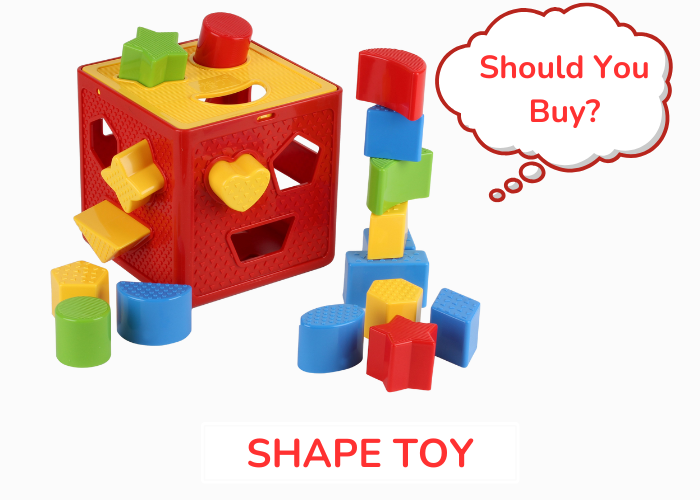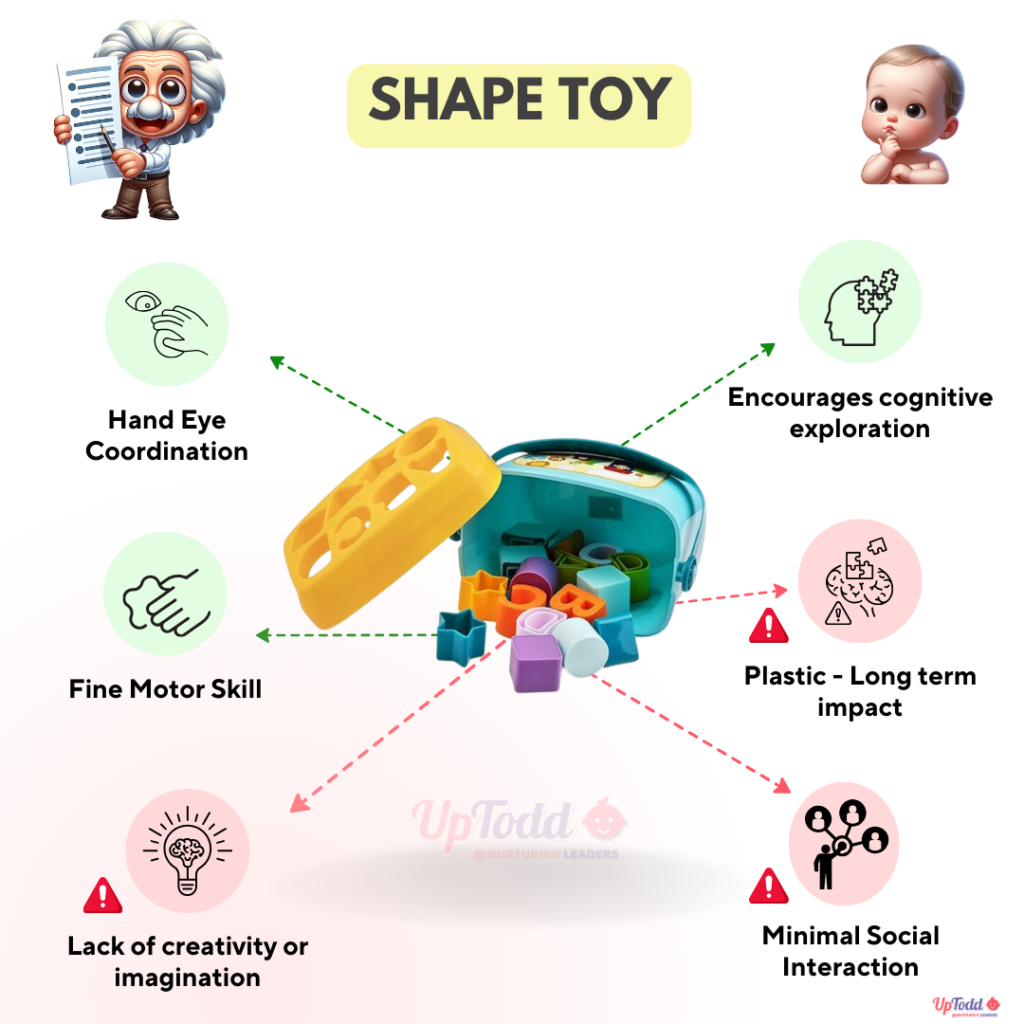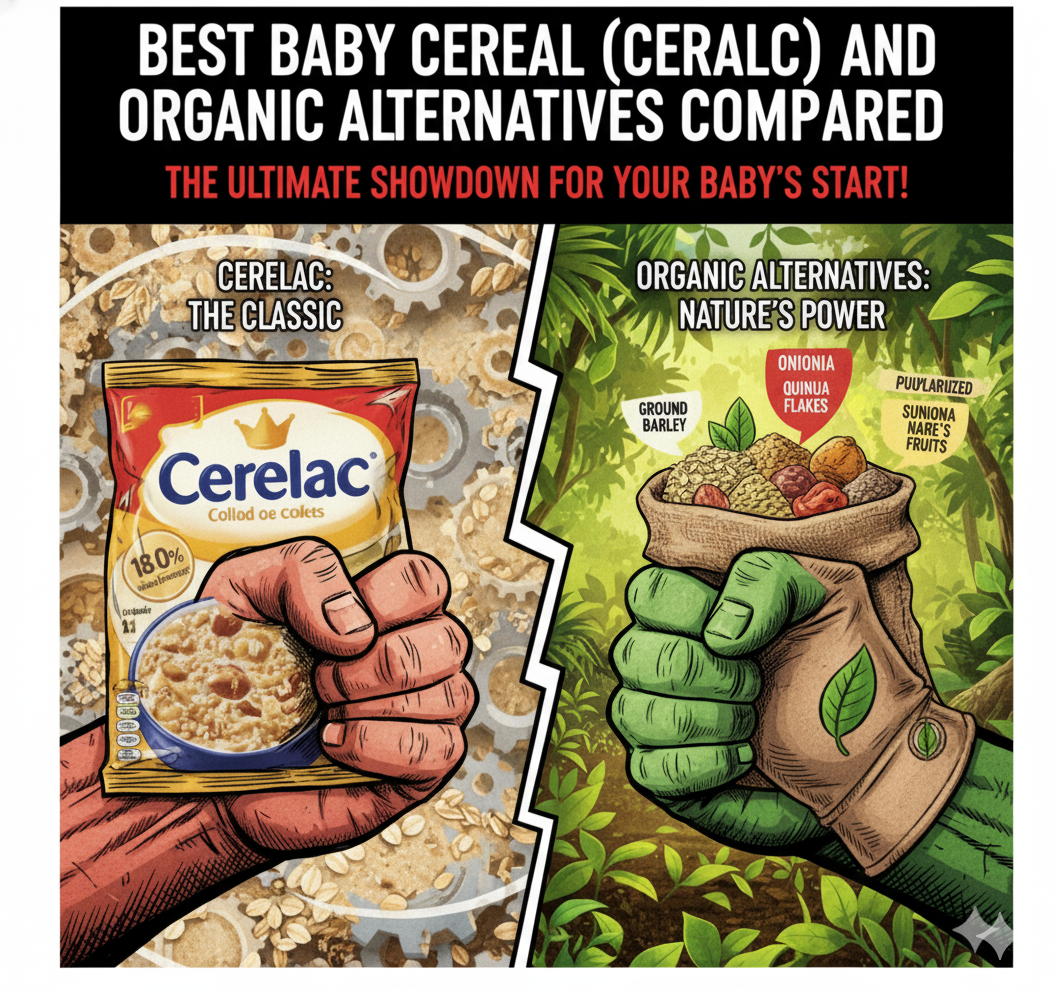
Shape Toy exploration: Its Benefits and Drawbacks
Topic
Shape Toy exploration: Its Benefits and Drawbacks
May start as early as
12 Months
─────────
Related Skills
Introduction to Shape Toy
Few toys have stood the test of time as well as the Shape Toy. Simple in design yet powerful in purpose, this classic educational toy remains a favorite among parents, caregivers, and educators. Whether it’s a wooden cube with shaped holes or a colorful plastic sorter, shape toys help babies and toddlers learn how the world fits together quite literally.
But just like any learning tool, not all shape toys are created equal. Some enhance problem-solving and coordination, while others may limit creativity or even pose environmental concerns.
In this article, we’ll dive deeper into what makes shape toys so beneficial, their potential drawbacks, and how to choose the right one for your child.
What We Will Cover in This Blog
- What are the benefits of the Shape Toy?
- What are the drawbacks or limitations?
- What is the ideal age to introduce shape toys?
- Expert advice on how to use them effectively.
- Answers to common parent FAQs about toy cleaning, learning, and development.

Pros of the Shape Toy
1. Improves Hand-Eye Coordination
The shape toy is one of the best tools for enhancing hand-eye coordination in toddlers. As your child picks up different shapes and fits them into corresponding slots, they learn to align their hand movements with visual input.
This repetitive activity strengthens the connection between their eyes and hands—an essential foundation for tasks like writing, eating, and dressing later in life.
Example: When a child learns to rotate a triangle block until it fits perfectly, they are not just “playing”; they are building the neural pathways for precision and focus.
2. Encourages Cognitive Exploration
Shape toys are built on the principle of trial and error. Toddlers experiment by fitting pieces into different holes until they succeed, which naturally develops problem-solving abilities.
This kind of exploration strengthens spatial awareness, logical reasoning, and memory retention. Over time, children begin to predict patterns, recall shapes, and categorize them by color, size, and texture.
(Reference: The Cognitive Benefits of Early Shape Learning, Early Childhood Research Review)
3. Strengthens Fine Motor Skills
Manipulating the small pieces in a shape sorter requires grasping, turning, and placing all of which improve fine motor skills.
These repetitive hand motions strengthen finger muscles and enhance dexterity, preparing toddlers for everyday activities like tying shoelaces, using utensils, or holding pencils.
To boost this further, UpTodd experts recommend mixing shape toys with stacking rings or bead threading toys, which build both strength and precision.
4. Promotes Patience and Focus
Shape sorting can be surprisingly challenging for toddlers. Finding which piece fits where requires attention, perseverance, and patience. As children repeat the task, they begin to understand that persistence leads to success a valuable life lesson.
Encouraging them to explore without rushing develops both confidence and a healthy sense of accomplishment.
5. Educational Foundation for Math and Colors
Shape toys introduce basic geometry and early math concepts. Sorting shapes teaches children to compare, match, and classify, laying the groundwork for counting and problem-solving.
Many shape toys also feature bright colors, which aid in color recognition and visual memory.
You can also explore our blog on Montessori Toys – How to Choose Them for Your Toddler
Cons of the Shape Toy
1. Plastic and Environmental Concerns
A common issue with shape toys on the market is their plastic construction. While lightweight and inexpensive, plastic toys may contain chemicals such as BPA or phthalates and contribute to long-term waste.
Parents looking for a sustainable choice should consider wooden shape sorters with non-toxic paint. Wooden toys are safer, biodegradable, and often more durable.
You can read: Why Wooden Toys Must Be Your Baby’s Toys
2. Limited Creativity
Although shape toys build logic and coordination, they are inherently structured there’s usually one “correct” way to play. Unlike open-ended toys such as blocks or play silks, they don’t leave much room for imaginative storytelling or pretend play.
To counter this, combine shape sorting with creative play activities, like naming the shapes as characters or creating patterns with the pieces.
3. Minimal Social Interaction
Shape toys are typically designed for individual play, meaning they don’t naturally encourage teamwork or cooperative learning. While two children can play alongside each other, it rarely promotes communication or shared problem-solving.
Parents can enhance social skills by turning sorting into a shared gamefor instance, taking turns finding and naming shapes together.
4. Outgrowing the Toy Too Soon
Children may quickly master shape sorting, especially between 18 and 30 months, after which the toy may lose its educational value. To maintain engagement, rotate toys frequently or introduce advanced puzzles and building sets that extend the same learning concepts.
Age Recommendations
The Shape Toy is recommended for children aged 12 to 36 months. As Caregivers should ensure the toy meets safety standards and inspect it regularly for signs of wear or damage.
Safety Tips:
- Always inspect the toy for loose or damaged parts.
- Choose toys that are large enough to avoid choking hazards.
- Opt for non-toxic paints and rounded edges for safe exploration.
Expert View: Dr. Nitin, Child Development Specialist (UpTodd)
“Shape toys are among the most effective early learning tools because they combine play and logic. However, parents must strike a balance. While these toys enhance motor and cognitive development, children also need unstructured, imaginative play to build creativity. A mix of shape sorters, stacking toys, and storytelling games provides the best all-round growth.”
How to Maximize the Benefits of Shape Toys
Introduce gradually: Start with simple shapes like circles and squares before moving to complex ones.
Play together: Engage your child by naming each shape and color aloud to reinforce vocabulary.
Encourage free exploration: Allow mistakes trial and error strengthens problem-solving.
Add challenges: As they grow, ask your child to sort shapes by color or count the pieces.
Combine with other toys: Use blocks or puzzles alongside shape sorters for broader learning.
Conclusion
The Shape Toy is a timeless classic for a reason. It nurtures coordination, cognitive thinking, and fine motor development in a fun, hands on way. However, parents should be aware of its limitations structured play can sometimes restrict creativity, and plastic versions may raise environmental or safety concerns.
By choosing sustainable, open-ended designs and balancing playtime with imagination based activities, you can help your child gain the best of both worlds: structured learning and creative growth.
Ultimately, shape toys are not just playthings they are stepping stones in your child’s journey toward independence, patience, and problem solving.
For expert guidance and personalized parenting insights, explore UpTodd, your trusted platform for evidence based child development solutions.
Thank you for joining us on this enlightening exploration. May your child’s playtime be filled with joy, learning, and endless moments of growth and discovery.
Explore UpTodd to unleash the hidden abilities of the baby.
FAQs
1. How do educational toys help child development?
Educational toys like shape sorters promote problem-solving, memory, and hand-eye coordination. They make learning enjoyable while strengthening creativity and logical reasoning.
2. How can I make baby toys at home?
Homemade shape toys can be made using cardboard boxes with cut-out holes or recycled lids as shapes. Always use child-safe materials and supervise playtime.
3. How can I clean baby toys that cannot be washed?
Wipe them gently with a damp cloth using mild soap or a baby-safe cleaner. Wooden toys should never be soaked wipe and let them air dry.
4. How can I clean baby toys with batteries?
Remove batteries before cleaning. Use a damp microfiber cloth and avoid water contact with electronic parts. Allow the toy to dry completely before reinserting batteries.
5. How can I disinfect baby toys safely?
Use a mixture of equal parts vinegar and water or mild baby-safe disinfectant wipes. Avoid harsh chemicals that could irritate your child’s skin.
6. How can I teach my toddler colors and shapes effectively?
Incorporate learning into play. Use shape sorters, building blocks, and flashcards. Reinforce learning by asking your child to identify shapes and colors in daily surroundings.
7. How can I store shape toys and other learning toys?
Use labeled storage bins or baskets. Sorting toys by type teaches children organization and responsibility.
Explore More
- Baby Toys: Best Picks (Master Cluster)
- Why Wooden Toys Must Be Your Baby’s Toys
- Montessori Toys – How to Choose Them for Your Toddler
- Hammer Ball Toy: Pros and Cons
- Dancing Cactus Toy: Is It Worth Your Investment?
Refrences
- Verdine BN, Zimmermann L, Foster L, Marzouk MA, Golinkoff RM, Hirsh-Pasek K, Newcombe N. Effects of Geometric Toy Design on Parent-Child Interactions and Spatial Language. Early Child Res Q. 2019 1st Quarter;46:126-141. doi: 10.1016/j.ecresq.2018.03.015. Epub 2018 May 18. PMID: 30555211; PMCID: PMC6289199.
- Verdine BN, Zimmermann L, Foster L, Marzouk MA, Golinkoff RM, Hirsh-Pasek K, Newcombe N. Effects of Geometric Toy Design on Parent-Child Interactions and Spatial Language. Early Child Res Q. 2019 1st Quarter;46:126-141. doi: 10.1016/j.ecresq.2018.03.015. Epub 2018 May 18. PMID: 30555211; PMCID: PMC6289199.
- Verdine BN, Lucca KR, Golinkoff RM, Hirsh-Pasek K, Newcombe NS. The Shape of Things: The Origin of Young Children’s Knowledge of the Names and Properties of Geometric Forms. J Cogn Dev. 2016 Jan 1;17(1):142-161. doi: 10.1080/15248372.2015.1016610. Epub 2015 Mar 31. PMID: 27019647; PMCID: PMC4808058.






